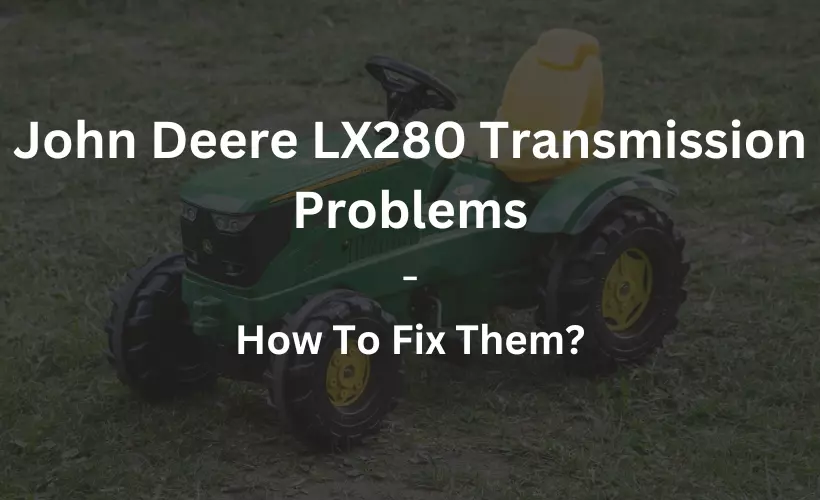John Deere LX280 is a popular lawn mower used by homeowners and professionals for maintaining lawns. It is designed with a robust transmission that delivers power to the wheels and enables the mower to move. However, like any other machine, the LX280 can experience transmission problems that can affect its performance and durability.
1. Common John Deere LX280 Transmission Problems
1.1 Transmission Won’t Engage
One of the most common problems with the John Deere LX280 transmission is when it won’t engage. This problem is usually caused by low transmission fluid levels, a faulty transmission filter, or a broken linkage. When the transmission won’t engage, the engine may start, but the mower won’t move.
1.2 Transmission Slips or Jerks
Another common problem with the John Deere LX280 transmission is when it slips or jerks. This problem is usually caused by worn-out transmission gears or a faulty drive pulley. When the transmission slips or jerks, the mower may move erratically or lose power.
1.3 Transmission Makes a Grinding Noise
If you hear a grinding noise coming from the John Deere LX280 transmission, it could be a sign of a serious problem. This noise is usually caused by worn-out gears or damaged transmission seals. If left unaddressed, this problem can cause the transmission to fail completely.
1.4 Transmission Overheats
The John Deere LX280 transmission can overheat if it is under a heavy load for an extended period. This problem is usually caused by low transmission fluid levels or a damaged transmission cooler. If the transmission overheats, it can cause significant damage to the machine.
2. How to Fix John Deere LX280 Transmission Problems
2.1 Check the Transmission Fluid Level
The first thing you should do if you experience transmission problems with your John Deere LX280 is to check the transmission fluid level. Low fluid levels can cause the transmission to fail to engage or overheat. Make sure the fluid level is at the recommended
2.2 Replace the Transmission Filter
If the transmission fluid level is correct, the next step is to check the transmission filter. A clogged filter can prevent the transmission fluid from flowing properly, causing the transmission to fail to engage or slip. If the filter is clogged, replace it with a new one.
2.3 Adjust the Transmission Linkage
If the transmission filter is not the problem, you should check the transmission linkage. A misaligned or damaged linkage can cause the transmission to fail to engage or slip. To fix this problem, adjust the linkage or replace it if it is damaged.
2.4 Replace the Transmission Belt
If the transmission belt is worn or damaged, it can cause the transmission to slip or jerk. To fix this problem, replace the transmission belt with a new one.
2.5 Inspect the Transmission Gears
If the transmission gears are worn or damaged, they can cause the transmission to slip or make a grinding noise. To fix this problem, inspect the gears and replace any that are damaged.
2.6 Check the Drive Pulleys
If the drive pulleys are worn or damaged, they can cause the transmission to slip or jerk. To fix this problem, inspect the drive pulleys and replace any that are worn or damaged.
2.7 Inspect the Transmission Seals
If the transmission seals are damaged or worn, they can cause the transmission to make a grinding noise or leak fluid. To fix this problem, inspect the seals and replace any that are damaged or worn.
2.8 Replace the Transmission
If none of the above solutions work, you may need to replace the entire transmission. This is a more expensive solution, but it may be necessary if the transmission is severely damaged.
3. Preventing John Deere LX280 Transmission Problems
To prevent transmission problems with your John Deere LX280, make sure to follow the manufacturer’s recommended maintenance schedule. This includes checking the transmission fluid level, replacing the transmission filter, and inspecting the transmission gears and drive pulleys regularly.
Additionally, avoid putting too much strain on the transmission by not overloading the machine or pulling heavy loads. Also, make sure to operate the machine at the recommended speed and avoid sudden starts and stops.
4. Common Questions: FAQs
Can I drive my John Deere LX280 with a faulty transmission?
No, it is not recommended to drive your John Deere LX280 with a faulty transmission as it can cause further damage to the machine.
How often should I replace the transmission filter on my John Deere LX280?
You should replace the transmission filter on your John Deere LX280 every 100 hours of operation or at least once a year.
Can I fix the transmission on my John Deere LX280 myself?
It depends on the severity of the problem. Some transmission problems can be fixed by the owner, but others may require the assistance of a professional mechanic.
How do I know if my John Deere LX280 transmission is overheating?
You may notice a burning smell or see smoke coming from the transmission if it is overheating. Additionally, the machine may start to lose power or fail to engage.
5. Conclusion
In conclusion, the John Deere LX280 is a powerful and reliable lawn mower, but it can experience transmission problems like any other machine. If you experience transmission problems with your LX280, follow the steps outlined in this article to diagnose and fix the problem. Additionally, make sure to follow the manufacturer’s recommended maintenance schedule to prevent transmission problems from occurring in the first place.
